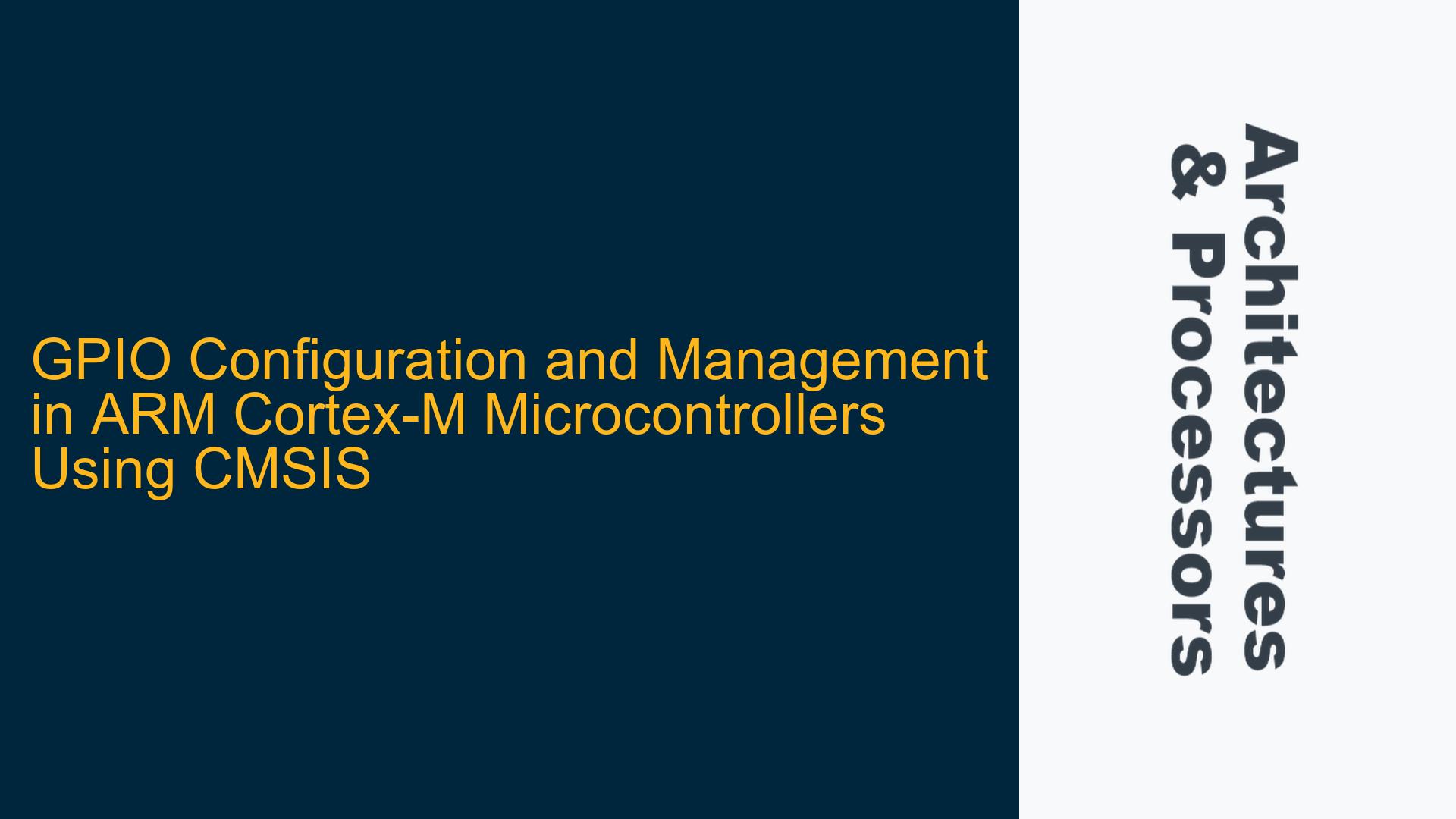GPIO Functionality in CMSIS-Driver and Standard Naming Conventions
The ARM Cortex-M microcontrollers are widely used in embedded systems due to their efficiency, scalability, and robust ecosystem. One of the key components of this ecosystem is the Cortex Microcontroller Software Interface Standard (CMSIS), which provides a standardized hardware abstraction layer for Cortex-M processors. However, a common point of confusion arises when developers attempt to locate GPIO (General Purpose Input/Output) functionality within the CMSIS-Driver framework. GPIO pins are fundamental to microcontroller applications, enabling interfacing with external devices, sensors, and actuators. Despite their importance, GPIO management is not explicitly covered under the CMSIS-Driver specification, leading to questions about how to configure and control GPIO pins using CMSIS.
The CMSIS-Driver API primarily focuses on standardizing interfaces for complex peripherals such as Ethernet, USB, and CAN, rather than basic peripherals like GPIO. This design choice reflects the fact that GPIO functionality is often highly vendor-specific, with variations in pin configurations, alternate functions, and electrical characteristics across different microcontroller families. However, CMSIS does provide a set of core functions and macros for GPIO management through the CMSIS-Core and CMSIS-Pack specifications. These functions are typically implemented in the device-specific header files provided by microcontroller vendors, such as STM32, NXP, or Microchip.
A key aspect of GPIO management is the standardization of pin naming conventions. Microcontroller vendors often use proprietary naming schemes for GPIO pins, which can lead to confusion when porting code between different devices or families. CMSIS addresses this issue by defining a set of macros and enumerations that abstract the underlying hardware details. For example, the CMSIS-Core header files include definitions for GPIO port base addresses, pin numbers, and alternate function mappings. These definitions allow developers to write portable code that can be easily adapted to different microcontrollers within the same family or across families.
Vendor-Specific GPIO Implementations and CMSIS Abstraction
The absence of GPIO functionality in the CMSIS-Driver specification is not an oversight but rather a deliberate design choice. GPIO pins are often tightly coupled with other peripherals, such as timers, communication interfaces, and analog-to-digital converters. This tight integration makes it difficult to define a one-size-fits-all API for GPIO management. Instead, CMSIS provides a framework for vendors to implement GPIO functionality in a way that aligns with their specific hardware architecture.
For example, STMicroelectronics provides a comprehensive set of GPIO functions in their STM32 HAL (Hardware Abstraction Layer) library, which is built on top of CMSIS. These functions include GPIO initialization, configuration, and control, as well as support for advanced features such as interrupt handling and alternate function selection. Similarly, NXP offers a set of GPIO drivers for their LPC and Kinetis microcontrollers, which are also CMSIS-compliant. These vendor-specific implementations ensure that developers have access to the full range of GPIO features while maintaining compatibility with the CMSIS framework.
The CMSIS-Pack specification further enhances GPIO management by providing a standardized way to describe microcontroller peripherals, including GPIO pins, in XML format. This description is used by development tools, such as Keil MDK and IAR Embedded Workbench, to generate device-specific initialization code and provide context-sensitive help. For example, the CMSIS-Pack description for an STM32 microcontroller includes details about the GPIO port registers, pin configurations, and alternate function mappings. This information is used by the development tools to generate the appropriate CMSIS-Core header files and startup code.
Best Practices for GPIO Configuration and Management Using CMSIS
To effectively manage GPIO pins using CMSIS, developers should follow a set of best practices that ensure code portability, maintainability, and performance. These practices include using the CMSIS-Core macros and enumerations for GPIO configuration, leveraging vendor-specific HAL libraries for advanced features, and adhering to the CMSIS-Pack specification for device-specific descriptions.
The first step in GPIO configuration is to define the pin mode, which determines whether the pin is used as an input, output, or alternate function. The CMSIS-Core header files provide a set of macros for this purpose, such as GPIO_MODE_INPUT, GPIO_MODE_OUTPUT_PP (push-pull), and GPIO_MODE_AF_PP (alternate function push-pull). These macros abstract the underlying register-level details, making it easier to write portable code. For example, the following code snippet configures GPIO pin PA5 as an output pin on an STM32 microcontroller:
#include "stm32f4xx.h" // Device header
void GPIO_Init(void) {
// Enable GPIOA clock
RCC->AHB1ENR |= RCC_AHB1ENR_GPIOAEN;
// Configure PA5 as output
GPIOA->MODER &= ~(3U << (5 * 2)); // Clear mode bits
GPIOA->MODER |= (1U << (5 * 2)); // Set mode to output
GPIOA->OTYPER &= ~(1U << 5); // Set output type to push-pull
GPIOA->OSPEEDR |= (3U << (5 * 2)); // Set speed to high
GPIOA->PUPDR &= ~(3U << (5 * 2)); // Disable pull-up/pull-down
}
In this example, the GPIOA->MODER register is used to set the mode of pin PA5, while the GPIOA->OTYPER and GPIOA->OSPEEDR registers configure the output type and speed, respectively. The RCC->AHB1ENR register enables the clock for GPIOA, which is necessary for accessing the GPIO registers. This code is specific to the STM32F4 series but can be easily adapted to other STM32 families by modifying the register definitions.
For more advanced GPIO features, such as interrupt handling and alternate function selection, developers should use the vendor-specific HAL libraries. These libraries provide a higher-level API that abstracts the low-level register access, making it easier to implement complex functionality. For example, the STM32 HAL library includes functions for configuring GPIO interrupts, such as HAL_GPIO_Init() and HAL_GPIO_EXTI_IRQHandler(). These functions handle the configuration of the EXTI (External Interrupt) controller and the NVIC (Nested Vectored Interrupt Controller), which are necessary for GPIO interrupt handling.
The CMSIS-Pack specification plays a crucial role in GPIO management by providing a standardized way to describe microcontroller peripherals. This description is used by development tools to generate device-specific initialization code and provide context-sensitive help. For example, the CMSIS-Pack description for an STM32 microcontroller includes details about the GPIO port registers, pin configurations, and alternate function mappings. This information is used by the development tools to generate the appropriate CMSIS-Core header files and startup code.
In conclusion, while GPIO functionality is not explicitly covered under the CMSIS-Driver specification, CMSIS provides a robust framework for GPIO management through the CMSIS-Core and CMSIS-Pack specifications. By following best practices and leveraging vendor-specific HAL libraries, developers can effectively configure and control GPIO pins in ARM Cortex-M microcontrollers. This approach ensures code portability, maintainability, and performance, making it easier to develop complex embedded systems.






